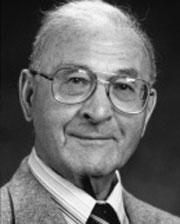Harry Angelman
Harry Angelman | |
|---|---|
 | |
| Born | 13 August 1915 |
| Died | 8 August 1996 (aged 80) |
| Cause of death | Colon Tumour |
| Nationality | British |
| Spouse | Audrey |
Harry Angelman (13 August 1915 – 8 August 1996) was a British consultant paediatrician who identified Angelman Syndrome.
Biography
Angelman was born in Birkenhead in 1915 and qualified in Liverpool. Angelman was an enthusiast for the language and country of Italy. He had observed three children who were unrelated but showed similar symptoms (severe intellectual disablement, lack of speech, motor disorders, and happy demeanors). He was in two minds as to whether he should publish his findings but he described seeing a painting which seemed to characterise the symptoms he had observed. The painting showed a boy with a puppet and was by the renaissance artist Giovanni Francesco Caroto.[1]
The painting showed a child and a puppet and at first his 1965 paper described what he called "puppet children".[2] His paper was not immediately recognised as important but later similar children led to the idea being renamed Angelman syndrome.[1] An American Angelman Syndrome Support Group was started in Waterlooville, Hampshire in 1986.[3]
Angelman travelled to talk about his discovery and his work was mentioned as important by U.S. President Bill Clinton. Angelman died due to a colon tumour.[1]
References
- ^ a b c Obituary, British Medical Journal
- ^ Angelman, Harvey (1965). "'Puppet' Children: A report of three cases". Dev Med Child Neurol. 7: 681–688. doi:10.1111/j.1469-8749.1965.tb07844.x.
- ^ Harry Angelman, Munks Roll, accessed September 2010
